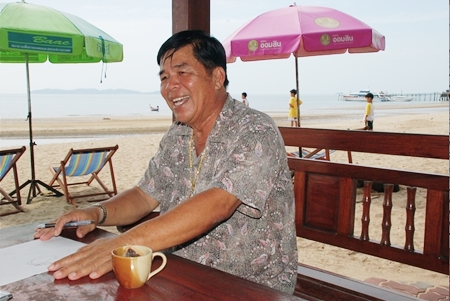Koh Talu, Thailand (dpa) – Prida Chareonpak, 67, makes an unlikely conservationist.
Once the owner of a fleet of fishing boats, Prida at the peak of his career was reaping more than 20,000 dollars worth of seafood a day from the Gulf of Thailand. But when the fish in the gulf started to get scarcer he had a change of heart.
“I could have gone overseas to catch fish, but I thought, ‘Why should I go? Why not try to restock the fish here?’” Prida said. Here was Talu Island, or Koh Talu, a small island (234 hectares) off the coast of Prachaub Khiri Khan province, about 270 kilometers south of Bangkok, whose reefs and protective bays have provided a safe haven and spawning ground for Pla tu, the ubiquitous mackerel, and other fish species for ages.
 Prida Chareonpak, fisherman-turned-conservationist, has dedicated the second half of his life to rehabilitating the environment around Talu Island. (Photo Credit: Ton Gerrits)
Prida Chareonpak, fisherman-turned-conservationist, has dedicated the second half of his life to rehabilitating the environment around Talu Island. (Photo Credit: Ton Gerrits)
Koh Talu is one of Thailand’s few privately owned islands – there are about three or four in the kingdom, all bequeathed to private individuals by one of Thailand’s former kings. In 1977 Prida started buying up Koh Talu from the previous owners. To do so – at the cost of about 40 million baht (1.3 million dollars) – he had to sell his fleet of 13 fishing vessels.
After persuading local authorities to declare the vicinity around Talu a natural preservation zone about 25 years ago, Prida’s metamorphosis from fish killer to savior began.
“We had to fight with big fishing boats that were trying to break the law, and with small local fishermen who were using dynamite to kill the fish,” Prida recalled. “It took a while.”
 Wooden jetty on Big Bay, Talu Island. Situated about 600 kilometers south of the capital on the Andaman Sea coast, the Bang Saphan neighborhood is becoming an increasingly popular stopover for tourists bored of Thailand’s better known attractions. (Photo Credit: Ton Gerrits)
Wooden jetty on Big Bay, Talu Island. Situated about 600 kilometers south of the capital on the Andaman Sea coast, the Bang Saphan neighborhood is becoming an increasingly popular stopover for tourists bored of Thailand’s better known attractions. (Photo Credit: Ton Gerrits)
Initially, Prida was more concerned with restoring Koh Talu’s environment than turning it in to a tourist destination, but his children had other ideas. In 1996 eldest son Thanapoom built three bungalows on Talu’s Big Bay beach, charging visitors 600 baht (20 dollars) a day for accommodation, food and snorkeling. The bungalows attracted a trickle of backpackers from Khaosan Road, Bangkok’s notorious cheap neighborhood for budget travelers.
“Those people can always find somewhere new,” said Phaopipat, Prida’s second son and current manager of Koh Talu Island Resort. The resort, the only one on the island, is no longer charging 600 baht a night.
A two-day tour of the island, including a bus trip from Hua Hin beach resort (125 kilometers north of Koh Talu), speed boat trips to the island and back, accommodation in one of the resort’s 62 air-conditioned rooms, and snorkeling or scuba diving excursions, costs about 5,000 baht (160 dollars).
Talu provides the closest decent snorkeling venue for tourists staying at Hua Hin, one of Thailand’s popular beach resorts which is just a three-hour drive from Bangkok. Although Hua Hin offers plenty of five-star hotels with large swimming pools, water sports and sunbathing, there is nothing to see with a snorkel except a few jellyfish.
 Koh Talu, named after the tunnel that defines its western tip. Talu means tunnel in Thai. Talu provides the closest decent snorkeling venue for tourists staying at Hua Hin, one of Thailand’s popular beach resorts which is just a three-hour drive from Bangkok. (Photo Credit: Ton Gerrits)
Koh Talu, named after the tunnel that defines its western tip. Talu means tunnel in Thai. Talu provides the closest decent snorkeling venue for tourists staying at Hua Hin, one of Thailand’s popular beach resorts which is just a three-hour drive from Bangkok. (Photo Credit: Ton Gerrits)
The nearest reef is at Koh Talu, part of the Bang Saphan district of Prachuab Khiri Khan.
Situated half way between Bangkok and Phuket, Thailand’s most popular resort island situated about 600 kilometers south of the capital on the Andaman Sea coast, the Bang Saphan neighborhood is becoming an increasingly popular stopover for tourists bored of Thailand’s better known attractions.
“Most of our guests come straight to Bang Saphan from Bangkok, spend three nights here and then travel on to Phuket,” said Anirach Sunthathip, desk manager of the Bangsaphan Coral Resort, which caters to French tourists.
Koh Talu Island Resort allows private dive boats to take tourists to two designated snorkeling spots on the reef around the island, but does not permit them to land.
“They are limited to two snorkeling spots, so if the reef is destroyed, it will only be in those areas,” Prida said.
His battle to preserve the island’s environment has apparently shifting from fighting fishermen to fighting dive boat operators and their passengers.
“The reef has improved a lot but now there are about 1,000 people visiting it every day,” Prida said. “For foreign tourists it is no big problem because they understand about conservation, but the Thai tourists wear life jackets, play loud music, step on the coral and want to take chunks of it home as souvenirs.”
Prida has adopted a philosophical attitude to his struggle. “We have to gradually teach people,” he said. “It may take 100 years, but we will eventually be able to rehabilitate this area.”




